2007 CHEVROLET CORVETTE child seat
[x] Cancel search: child seatPage 1 of 488

Seats and Restraint Systems
........................ 7
Front Seats
.............................................. 8
Safety Belts
............................................ 16
Child Restraints
...................................... 31
Airbag System
........................................ 50
Restraint System Check
......................... 66
Features and Controls
................................. 69
Keys
....................................................... 71
Doors and Locks
.................................... 78
Windows
................................................ 85
Theft-Deterrent Systems
......................... 87
Starting and Operating Your Vehicle
....... 89
Mirrors
.................................................. 108
OnStar
®System
................................... 114
Universal Home Remote System
.......... 118
Storage Areas
...................................... 130
Roof Panel
........................................... 134
Convertible Top
.................................... 139Instrument Panel
........................................ 153
Instrument Panel Overview
................... 156
Climate Controls
................................... 179
Warning Lights, Gages, and Indicators
... 188
Driver Information Center (DIC)
............ 207
Audio System(s)
................................... 244
Driving Your Vehicle
.................................. 273
Your Driving, the Road, and
Your Vehicle
...................................... 274
Towing
................................................. 315
Service and Appearance Care
................... 317
Service
................................................. 319
Fuel
...................................................... 321
Checking Things Under the Hood
......... 328
Rear Axle
............................................. 370
Bulb Replacement
................................ 371
Windshield Replacement
....................... 375
Windshield Wiper Blade Replacement
... 375
2007 Chevrolet Corvette Owner ManualM
1
Page 7 of 488
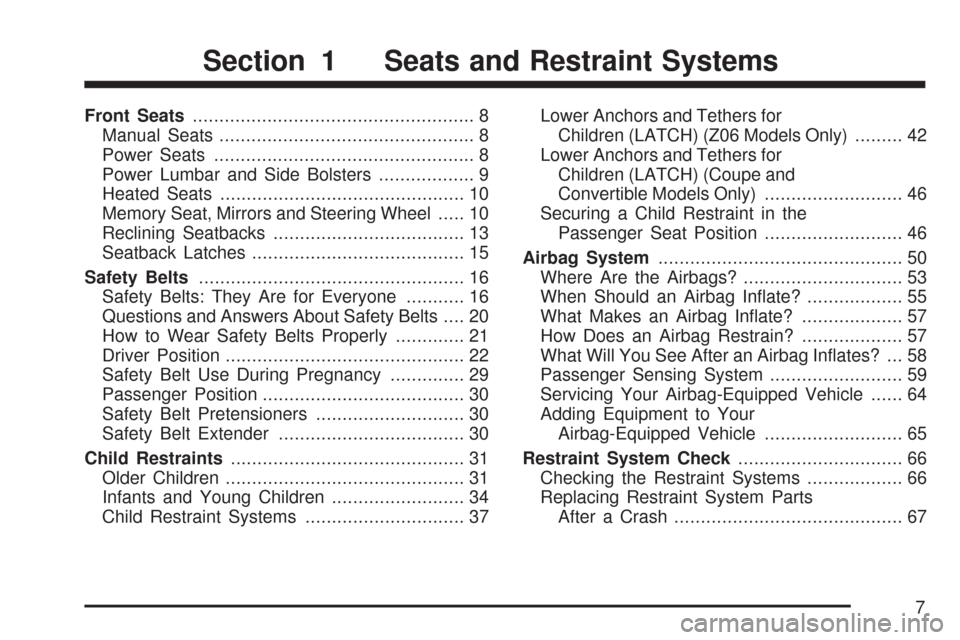
Front Seats..................................................... 8
Manual Seats................................................ 8
Power Seats................................................. 8
Power Lumbar and Side Bolsters.................. 9
Heated Seats.............................................. 10
Memory Seat, Mirrors and Steering Wheel..... 10
Reclining Seatbacks.................................... 13
Seatback Latches........................................ 15
Safety Belts.................................................. 16
Safety Belts: They Are for Everyone........... 16
Questions and Answers About Safety Belts.... 20
How to Wear Safety Belts Properly............. 21
Driver Position............................................. 22
Safety Belt Use During Pregnancy.............. 29
Passenger Position...................................... 30
Safety Belt Pretensioners............................ 30
Safety Belt Extender................................... 30
Child Restraints............................................ 31
Older Children............................................. 31
Infants and Young Children......................... 34
Child Restraint Systems.............................. 37Lower Anchors and Tethers for
Children (LATCH) (Z06 Models Only)......... 42
Lower Anchors and Tethers for
Children (LATCH) (Coupe and
Convertible Models Only).......................... 46
Securing a Child Restraint in the
Passenger Seat Position.......................... 46
Airbag System.............................................. 50
Where Are the Airbags?.............................. 53
When Should an Airbag In�ate?.................. 55
What Makes an Airbag In�ate?................... 57
How Does an Airbag Restrain?................... 57
What Will You See After an Airbag In�ates? ... 58
Passenger Sensing System......................... 59
Servicing Your Airbag-Equipped Vehicle...... 64
Adding Equipment to Your
Airbag-Equipped Vehicle.......................... 65
Restraint System Check............................... 66
Checking the Restraint Systems.................. 66
Replacing Restraint System Parts
After a Crash........................................... 67
Section 1 Seats and Restraint Systems
7
Page 30 of 488
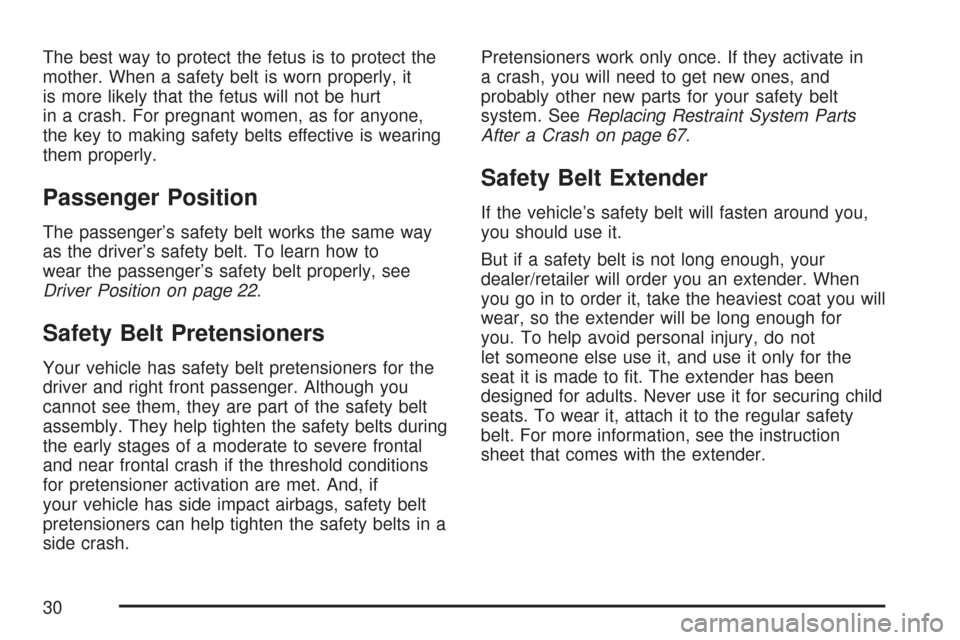
The best way to protect the fetus is to protect the
mother. When a safety belt is worn properly, it
is more likely that the fetus will not be hurt
in a crash. For pregnant women, as for anyone,
the key to making safety belts effective is wearing
them properly.
Passenger Position
The passenger’s safety belt works the same way
as the driver’s safety belt. To learn how to
wear the passenger’s safety belt properly, see
Driver Position on page 22.
Safety Belt Pretensioners
Your vehicle has safety belt pretensioners for the
driver and right front passenger. Although you
cannot see them, they are part of the safety belt
assembly. They help tighten the safety belts during
the early stages of a moderate to severe frontal
and near frontal crash if the threshold conditions
for pretensioner activation are met. And, if
your vehicle has side impact airbags, safety belt
pretensioners can help tighten the safety belts in a
side crash.Pretensioners work only once. If they activate in
a crash, you will need to get new ones, and
probably other new parts for your safety belt
system. SeeReplacing Restraint System Parts
After a Crash on page 67.
Safety Belt Extender
If the vehicle’s safety belt will fasten around you,
you should use it.
But if a safety belt is not long enough, your
dealer/retailer will order you an extender. When
you go in to order it, take the heaviest coat you will
wear, so the extender will be long enough for
you. To help avoid personal injury, do not
let someone else use it, and use it only for the
seat it is made to �t. The extender has been
designed for adults. Never use it for securing child
seats. To wear it, attach it to the regular safety
belt. For more information, see the instruction
sheet that comes with the extender.
30
Page 31 of 488
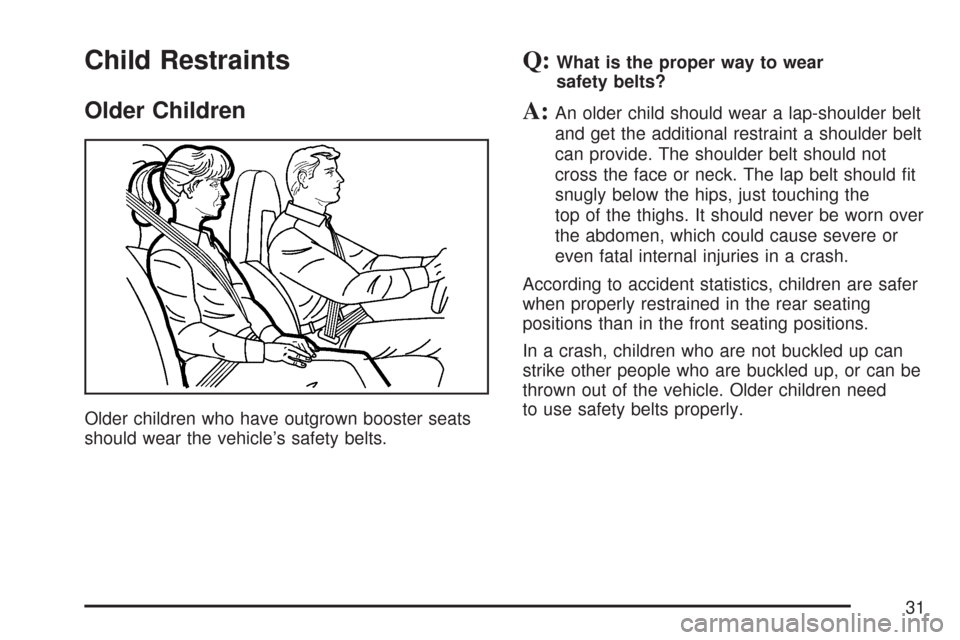
Child Restraints
Older Children
Older children who have outgrown booster seats
should wear the vehicle’s safety belts.
Q:What is the proper way to wear
safety belts?
A:An older child should wear a lap-shoulder belt
and get the additional restraint a shoulder belt
can provide. The shoulder belt should not
cross the face or neck. The lap belt should �t
snugly below the hips, just touching the
top of the thighs. It should never be worn over
the abdomen, which could cause severe or
even fatal internal injuries in a crash.
According to accident statistics, children are safer
when properly restrained in the rear seating
positions than in the front seating positions.
In a crash, children who are not buckled up can
strike other people who are buckled up, or can be
thrown out of the vehicle. Older children need
to use safety belts properly.
31
Page 33 of 488
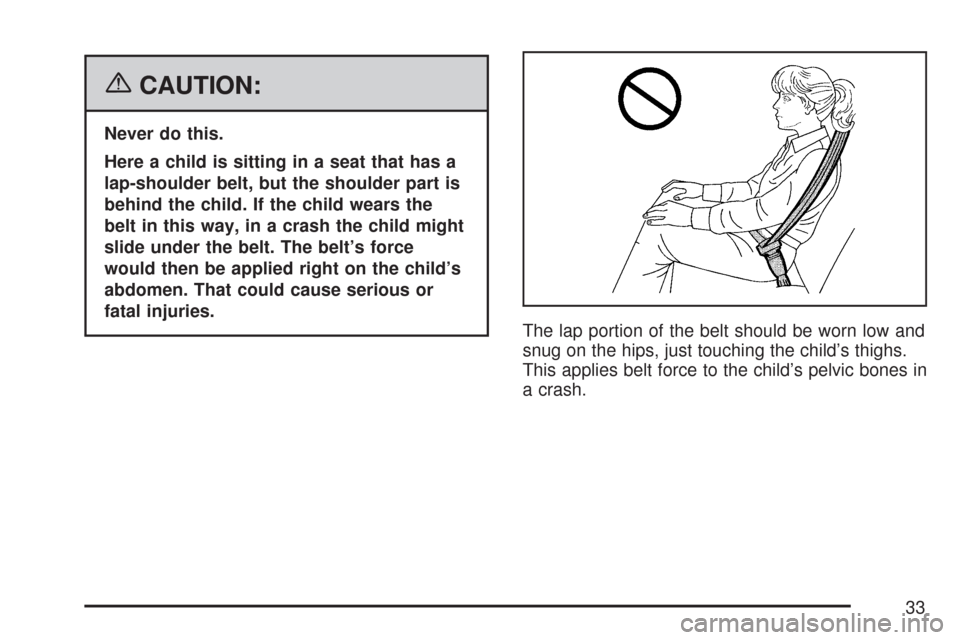
{CAUTION:
Never do this.
Here a child is sitting in a seat that has a
lap-shoulder belt, but the shoulder part is
behind the child. If the child wears the
belt in this way, in a crash the child might
slide under the belt. The belt’s force
would then be applied right on the child’s
abdomen. That could cause serious or
fatal injuries.
The lap portion of the belt should be worn low and
snug on the hips, just touching the child’s thighs.
This applies belt force to the child’s pelvic bones in
a crash.
33
Page 36 of 488
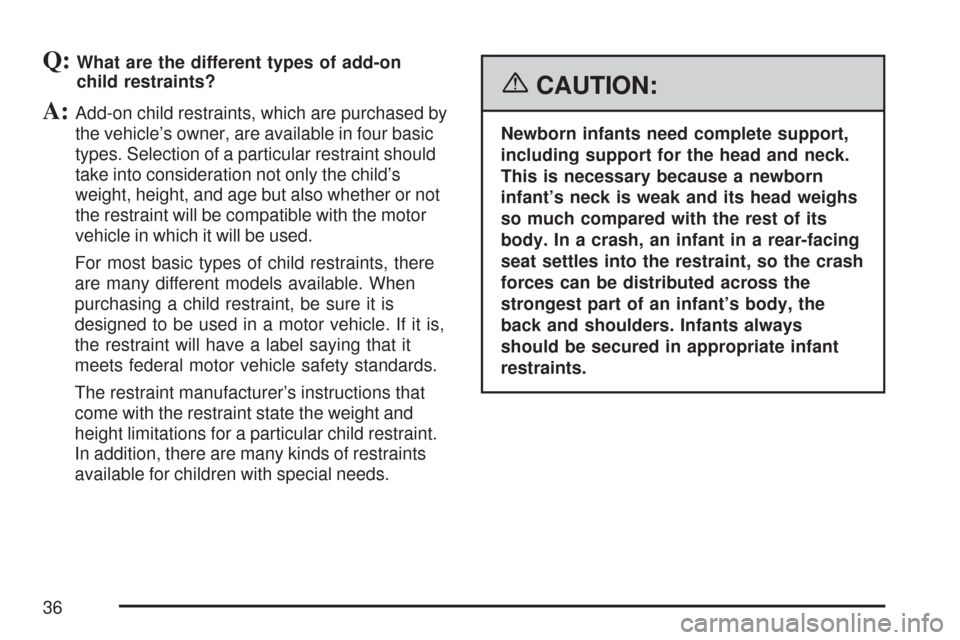
Q:What are the different types of add-on
child restraints?
A:Add-on child restraints, which are purchased by
the vehicle’s owner, are available in four basic
types. Selection of a particular restraint should
take into consideration not only the child’s
weight, height, and age but also whether or not
the restraint will be compatible with the motor
vehicle in which it will be used.
For most basic types of child restraints, there
are many different models available. When
purchasing a child restraint, be sure it is
designed to be used in a motor vehicle. If it is,
the restraint will have a label saying that it
meets federal motor vehicle safety standards.
The restraint manufacturer’s instructions that
come with the restraint state the weight and
height limitations for a particular child restraint.
In addition, there are many kinds of restraints
available for children with special needs.
{CAUTION:
Newborn infants need complete support,
including support for the head and neck.
This is necessary because a newborn
infant’s neck is weak and its head weighs
so much compared with the rest of its
body. In a crash, an infant in a rear-facing
seat settles into the restraint, so the crash
forces can be distributed across the
strongest part of an infant’s body, the
back and shoulders. Infants always
should be secured in appropriate infant
restraints.
36
Page 38 of 488
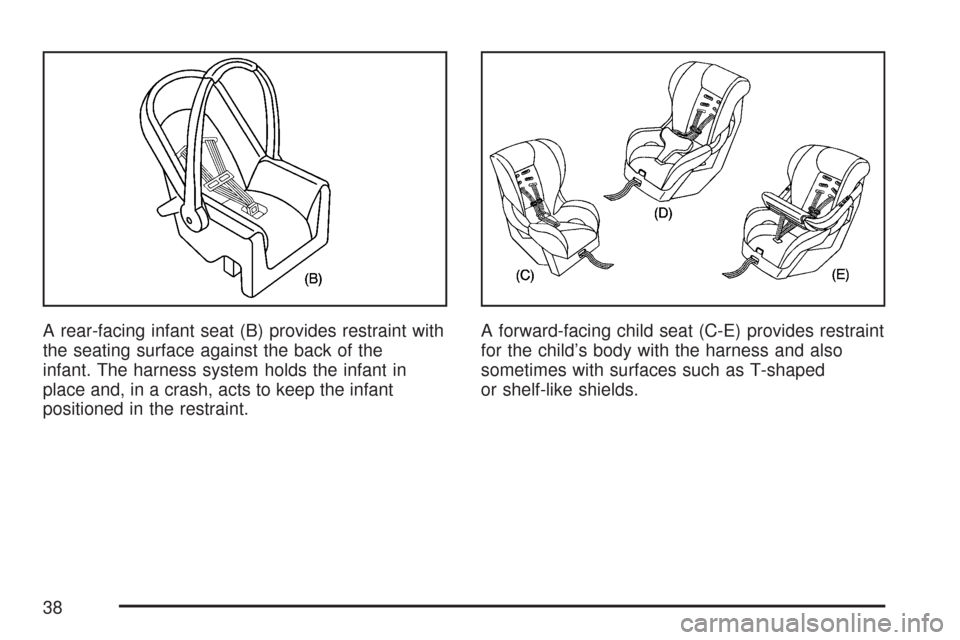
A rear-facing infant seat (B) provides restraint with
the seating surface against the back of the
infant. The harness system holds the infant in
place and, in a crash, acts to keep the infant
positioned in the restraint.A forward-facing child seat (C-E) provides restraint
for the child’s body with the harness and also
sometimes with surfaces such as T-shaped
or shelf-like shields.
38
Page 39 of 488

A booster seat (F-G) is a child restraint designed
to improve the �t of the vehicle’s safety belt
system. Some booster seats have a shoulder belt
positioner, and some high-back booster seats
have a �ve-point harness. A booster seat can also
help a child to see out the window.
Q:How Should I Use a Child Restraint?
A:A child restraint system is any device designed
for use in a motor vehicle to restrain, seat, or
position children. A built-in child restraint
system is a permanent part of the motor
vehicle. An add-on child restraint system is a
portable one, which is purchased by the
vehicle’s owner. To help reduce injuries, an
add-on child restraint must be secured in
the vehicle. With built-in or add-on child
restraints, the child has to be secured within
the child restraint.
When choosing an add-on child restraint, be
sure the child restraint is designed to be
used in a vehicle. If it is, it will have a label
saying that it meets federal motor vehicle
safety standards. Then follow the instructions
for the restraint. You may �nd these
instructions on the restraint itself or in a
booklet, or both.
39